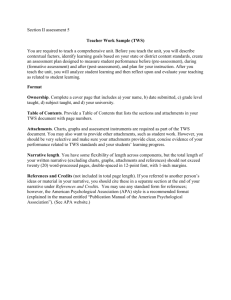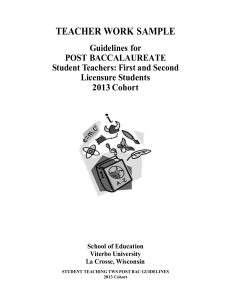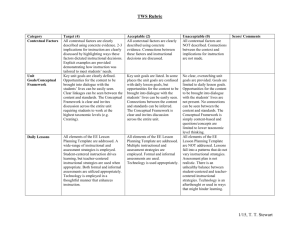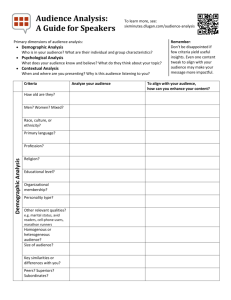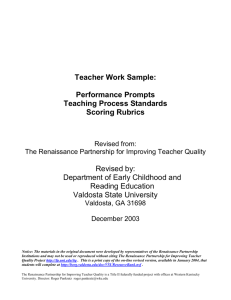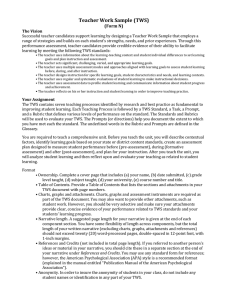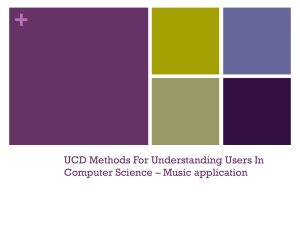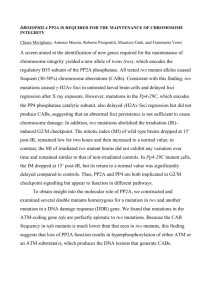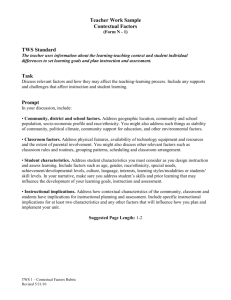Teacher Work Sample Contextual Factors Learning Goals
advertisement
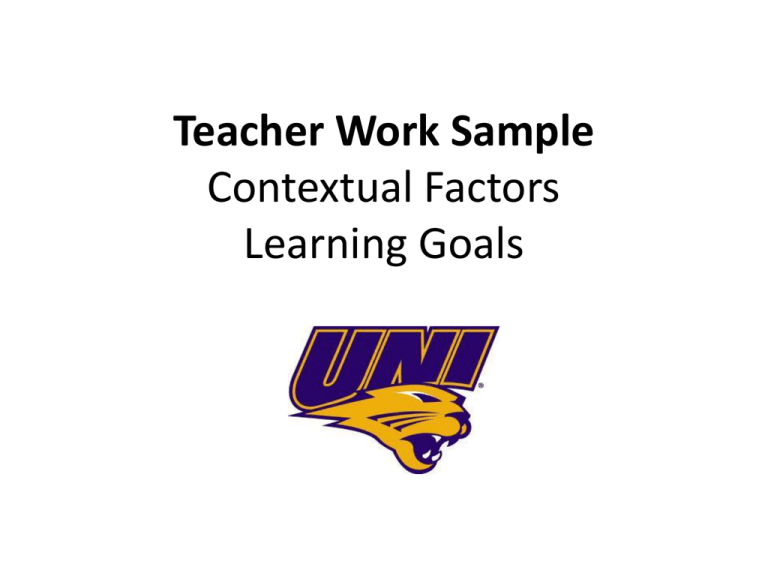
Teacher Work Sample Contextual Factors Learning Goals The Teacher Work Sample • An attempt to sample your ability to do “teacher work”. “teacher work=student learning” • All teachers do this work, but the TWS asks you to write out aspects of teacher work that is done mentally or without conscious thought at times. • This work includes: understanding contextual factors: aligning learning goals, instruction, and assessment; making instructional decisions; analyzing data, and reflecting and self-evaluation. Contextual Factors • Knowledge of community, district, school, and classroom factors • Knowledge of student characteristics and varied approaches to learning • Knowledge of student’s skills and prior learning (whole group and identified students) • Implications for instructional planning and assessment Why Contextual factors are Important • The most effective instruction and assessment comes from decisions made based on an objective understanding of the community, district, school, whole class characteristics and knowledge of your individual students’ strengths and abilities. • You’ll be asked to reference back to your contextual factors in chapters: Chapter 2, Chapter 3, chapter 4, and chapter 7 Devote more space to the contextual factors of students over community, district and classroom • Knowledge of community, district, school and classroom • Knowledge of student characteristics • Knowledge of students’ skills (whole group/and selected students) • • • • • • Make a list of community characteristics Make a list of district characteristics Make a list of building characteristics Make a list of classroom characteristics Make a list of student class characteristics Identify one student (student A) and what are some characteristics you’ve noted about student so far. Which of these contextual factors would be relevant to your TWS? • The district has a student population of 850 students k12 • The community is primarily middle to upper-middle class social economic status • The classroom has 24 student desks, white boards on two walls, and reading table near the back. • This is a required class that all students must take before graduation • Of the 22 students in the class, five of the students are identified as English Language learners. ¾ of class is currently reading below grade level • The daily schedule consists of 4 block classes of 90 minutes that alternate between “A” and “B” days. • The technology in the room includes a CD player, an elmo and two computers for student use. • The class consists of 18 students of which 12 are males. • The district recently passed a bond issue for construction of a new middle school. Relevance, relevance, RELEVANCE • Description vs identifying relevant characteristics. • Which characteristics are most relevant to you as you plan your instruction and assessment ? • Rely on your professional judgment which characteristics are the most relevant. • Go back through your list and identify the characteristics that are most relevant in your decision making Implications You need at least four implications: One from the characteristics of community, school, & classroom; one from class characteristics; one from student skills (group or individual students) “Implication” is a noun: it identifies something suggested or implied by a contextual factor. For each one of your starred characteristics, write a possible implication for that characteristic. A couple of hints • This chapter should be 6-8 pages long. If it’s longer, you may be giving too much description. • Use the word “implication” in your text and bold it; scorers find that easier to identify your implications. • You’ll not include town, school, or student names in your chapter; but you can edit these out of your TWS near the end. Chapter 2 Learning Goals • What do you want students to know or be able to do as a result of your planning and instruction? • Chapters 3, 4, and 6 all align with your learning goals. Learning Goals • Goals reflect varied levels of learning and are significant and challenging Use a learning theory, such as Blooms’ revised Taxonomy, to indicate the different levels of learning of your goals. You should have 3 to 6 learning goals. Too few and it’s hard to show different levels of learning; too many and your TWS will get too long as you deal with each goal in later chapters. • Goals are clearly stated at learning outcomes • Focus on specific learning outcomes of the series of lessons you’re teaching. • Don’t include year-long goals • Goals should not be activities unless you’re dealing with a performance based content. • Goals are appropriate for the development; pre-requisite knowledge, skills, experiences; or other student needs • Done in a narrative manner where you discuss why the goals are appropriate for your group of students; might include scope and sequence or district expectations • Goals are explicitly aligned with national, state or local standards • It’s best to find the district goals and indicate which district goals are being met with each of your goal. • Show the connection with the Iowa core curriculum • You don’t have to use all three levels of standards to align your goals with Evaluate each of these learning goals • Students will gain an appreciation for poetry • Students will become better citizens in society • Students will be able to recall the causes of world war one, discuss how world war one contributed to the cause of WW II, and what role each world leader played as the war approached. • Students will understand the rules of basketball • Students will be able to identify the seven continents with 100% accuracy • Students will write a short story • Students will compare poems by Poe and Dickenson recognizing different literary devices used by each poet. • Student’s watercolor painting will demonstrate their use of the dry brush technique. • Although learning goals that are easy to quantify and make the TWS easier; if you have learning goals that have higher levels of learning or involve a performance or creation element; assessing those goals may require a set of criteria for assessment. This will be one of the shorter chapters, but most critical. Your learning goals must align with assessment (chap. 3), instruction (chapter 4), analysis of learning (chap. 6), and references reflection and evaluation (chap. 7) Hints for this chapter • Label each goal in some logical manner (ex: LG 1, LG 2) • There may be other goals for your unit that you don’t include in your TWS. Just be aware in your assessments that you may just be pulling out the assessment pieces that address your LG. • You can have both qualitative goals and quantitative goals. • Alignment!!

